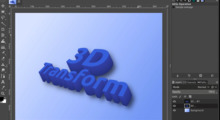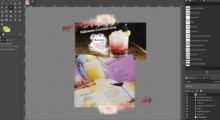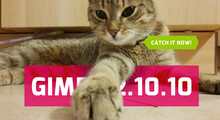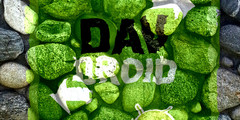digested: printing presses, cmyk, tiff + pdf...
This discussion is connected to the gimp-developer-list.gnome.org mailing list which is provided by the GIMP developers and not related to gimpusers.com.
This is a read-only list on gimpusers.com so this discussion thread is read-only, too.
digested: printing presses, cmyk, tiff + pdf...
hey crew,
this whole pdf/cmyk discussion has been a nice exercise for me in getting to "know the activity" as Don Norman calls it.
this is what I digest from all that has been said here:
rule #1: the topic we are talking all the time about here is not cmyk, tiff or pdf. the topic we are talking about is
mastering for the printing press
everything evolves around that.
2) even though the printing press can be digital, plates is what it is all about. cmyk is the bleeding obvious way to set up those plates, but anything can happen (spot, CMKYGO).
3) control over what is on each plate, and then how they combine is the name of the game. I do not underestimate how much adjustment is needed for each plate (or multiple plates), basically the whole monochrome collection of image operations.
4) tiff or pdf? it is just a transport method. it is a strategic choice what to do first/better/at all.
5) there is the creative work to make the image and there is the mastering for the printing press. in general these two jobs randomly alternate during the life cycle of the image file. one moment there is creative development, the next there is work on the plates, then back to the creative part, etc.
6) if an image is in cmyk then we are stuffed when it comes to creative work. lots of operations/plugins will stop working or only via (implicit) cmyk->(other color model)->cmyk conversions, which are a no-no.
7) when opening a file in cmyk format, it has obviously been mastered for a printing press. either this mastering needs corrections, or this image is an 'found image' that goes into another creative work. the latter is better done in rgb (see 6).
8) trapping is an example of explicit printing press support.
9) it is necessary to set the same point on all plates to an exact ink value (think of setting a hard cmyk value for a block of text or selection of pixels).
after writing the above I have reread for the third time all the emails in the thread. AFAIK all the input in the thread is captured in the above observations.
my conclusions from this:
1) all creative work in GIMP is in rgb.
2) when it is one of those times (plural) to work on the printing press mastering of this file, then pull the "press projection" over the image window. now you can see the plates (similar to layers) and work on each or combinations.
3) the set-up of the press projection plates is of course the separation set-up (with printing press profile) and can be freely defined from the composite or individual layers of the image file (channel mixing on steroids). standard cmyk type of separations will be the bleeding obvious defaults to choose from. CMKYGO can easily be also a default.
4) flip the press projection up again and continue to work on the creative part. flip the press projection down again and the plates are updated from the image changes. with previous plate modifications applied on top.
5) the press projection set-up and all modifications made to the plates on the press projection are also saved in the GIMP file.
5) when it is time to send the printing press master then from the press projection it can be exported to a few suitable formats (tiff, pdf, ...).
6) importing a cmyk file? there should be a choice to either shove this straight into a press projection to do some mastering corrections, or to convert to rgb to be part of a new work of art.
whew,
--ps
founder + principal interaction architect man + machine interface works
http://mmiworks.net/blog : on interaction architecture
digested: printing presses, cmyk, tiff + pdf...
From: peter sikking
Date: Fri, 27 Mar 2009 01:20:48 +0100
this whole pdf/cmyk discussion has been a nice exercise for me in getting to "know the activity" as Don Norman calls it.
this is what I digest from all that has been said here:
rule #1: the topic we are talking all the time about here is not cmyk, tiff or pdf. the topic we are talking about is
mastering for the printing press
everything evolves around that.
I think the case of "text black" is a partial, qualified exception -- but it's arguable that it has any bearing on RGB vs. CMYK. It really means "the darkest, sharpest black that can be produced" regardless of rendering device. It could just as well be represented as RGB+K, or simply as a separate layer. I'd argue that it's actually a creative choice, though.
So I'd say that it's really not at odds with what you're saying.
Perhaps prepress tasks would better be implemented as a plugin (or set of plugins)? It's hard for me to see how trapping (for example) would make any sense at all as part of the core, but as a plugin it would make perfect sense. I know Adobe at least used to sell a product called TrapWise whose purpose in life was to do nothing but trapping. I don't know if it had a Photoshop plugin component or not.
digested: printing presses, cmyk, tiff + pdf...
I think I agree with 99% of what you wrote. Clarifications/quibbles:
(wait. Nevermind. Probably about 75%)
On Fri, 27 Mar 2009, peter sikking wrote:
4) tiff or pdf? it is just a transport method. it is a strategic choice what to do first/better/at all.
PDF isn't really appropriate for raster images, but printers know how to deal with them and some expect it.
1) all creative work in GIMP is in rgb.
Is currently? Or should be? I can agree that it is currently, but it should allow CMYK editing.
2) when it is one of those times (plural) to work on the printing press mastering of this file, then pull the "press projection" over the image window. now you can see the plates (similar to layers) and work on each or combinations.
This would make a very useful feature, but it must accompany full CMYK editing.
CMKYGO can easily be
also a default.
Probably not, for a few reasons. Hexachrome(R) is patent-encumbered, for starters.
4) flip the press projection up again and continue to work on the creative part. flip the press projection down again and the plates are updated from the image changes. with previous plate modifications applied on top.
Ah. This is needlessly complicated and would require two versions of the same image.
Remember--rich black is a necessary CMYK color and cannot be represented in RGB. Trapping images requires CMYK and the trapped image cannot be represented in RGB.
Changes to one image cannot be automatically transferred to the other without complicated transforms. This is far more than just RGB > CMYK. This would involve things like edge detection and intelligent algorithms to determine when a boundary between two colors in one version of the image has shifted and thus requires a change to the other version.
To put it simply, this solution would require probably twice as much work as CMYK editing would.
digested: printing presses, cmyk, tiff + pdf...
Robert Krawitz wrote:
From: peter sikking
this whole pdf/cmyk discussion has been a nice exercise for me in getting to "know the activity" as Don Norman calls it.
this is what I digest from all that has been said here:
rule #1: the topic we are talking all the time about here is not cmyk, tiff or pdf. the topic we are talking about is
mastering for the printing press
everything evolves around that.
I think the case of "text black" is a partial, qualified exception --
I have a hard time spotting what you mean. this is troubling because I will have to understand the everything to be able to drive the Ui side of the solution.
Perhaps prepress tasks would better be implemented as a plugin (or set of plugins)?
technically or user experience? it is essential to me that all this mastering for the printing press is in the document window of GIMP, with all the monochrome GIMP functionality available to optimise the plates.
--ps
founder + principal interaction architect man + machine interface works
http://mmiworks.net/blog : on interaction architecture
digested: printing presses, cmyk, tiff + pdf...
On Thu, 26 Mar 2009, Robert Krawitz wrote:
I think the case of "text black" is a partial, qualified exception -- but it's arguable that it has any bearing on RGB vs. CMYK. It really means "the darkest, sharpest black that can be produced" regardless of rendering device. It could just as well be represented as RGB+K, or simply as a separate layer. I'd argue that it's actually a creative choice, though.
It doesn't necessarily mean the darkest, but it does mean the sharpest. And you're right that it could essentially be represented as RGB+K.
Perhaps prepress tasks would better be implemented as a plugin (or set of plugins)? It's hard for me to see how trapping (for example) would make any sense at all as part of the core, but as a plugin it would make perfect sense. I know Adobe at least used to sell a product called TrapWise whose purpose in life was to do nothing but trapping.
Automatic trapping is actually not a bad idea for a plugin. You could have things like trap along path or edge detection trapping (which I used as an example of something that would be prohibitively expensive in an interactive mode, but in one-time mode wouldn't be an issue).
It would, in general, be a very dumb plugin, but some simple jobs don't need intelligent algorithms to determine that we don't need the red eye effect trapped but that the magenta hankerchief in the suit pocket does need to be, just to trap the edge of the photo that got torn and you're outlining with a black border.
I don't know if it had a Photoshop plugin component or not.
TrapWise began with Aldus and was subsequently acquired by Adobe. TrapWise is now owned by Kodak, who describe it thus[*]:
``TRAPWISE's streamlined workflow, intelligent trapping engine and flexible productivity tools combine to give you precision trapping whenever and wherever you need it.''
As I suggested in the other message, sophisticated automated trapping is probably going to be more difficult than simply implementing CMYK editing, since you're going to have to implement many of the same features--CMYK editing (batch, not interactive, granted), colorspace conversion, alterations to the XCF file format--plus a bunch of other features like advanced edge detection and an evaluation system to determine what needs to be trapped and what does not.
There's a reason why TrapWise was pulling in $7000 a copy in 2001 when CS2 Premium was only $1200.
[*]
digested: printing presses, cmyk, tiff + pdf...
Andrew A. Gill wrote:
I think I agree with 99% of what you wrote. Clarifications/quibbles: (wait. Nevermind. Probably about 75%)
I better explain some things before that drops even further >^}
4) tiff or pdf? it is just a transport method. it is a strategic choice what to do first/better/at all.
PDF isn't really appropriate for raster images, but printers know how to deal with them and some expect it.
there seemed to be (simply better specified) benefits to pdf. but I am sort of neutral on this file type issue.
1) all creative work in GIMP is in rgb.
Is currently? Or should be? I can agree that it is currently, but it should allow CMYK editing.
currently and will be. hold it one moment with the cmyk editing.
2) when it is one of those times (plural) to work on the printing press mastering of this file, then pull the "press projection" over the image window. now you can see the plates (similar to layers) and work on each or combinations.
This would make a very useful feature, but it must accompany full CMYK editing.
you see, IF you set up your separation as standard (default) cmyk, the plates are c, m, y and k and you are editing within the press projection cymk. with the full awareness that this is totally geared towards that printing press, which is a user requirement.
now the benefit of not hardwiring a cmyk mode in GIMP is that
it will be just as easy to set up a
spot(candy apple red) + black + spot(metallic silver) + spot(matt
lacquer)
separation, and work just as freely on it, with true preview.
and that is progress.
CMKYGO can easily be also a default.
Probably not, for a few reasons. Hexachrome(R) is patent- encumbered, for starters.
ouch. sorry to have mentioned it then.
4) flip the press projection up again and continue to work on the creative part. flip the press projection down again and the plates are updated from the image changes. with previous plate modifications applied on top.
Ah. This is needlessly complicated and would require two versions of the same image.
I think you can see from the above that you can work then however you
choose.
you will never have to touch the rgb side to get things exactly how
you want to if you simply keep working with the press projection
(in cmyk, no doubt in your case).
Remember--rich black is a necessary CMYK color and cannot be represented in RGB. Trapping images requires CMYK and the trapped image cannot be represented in RGB.
Changes to one image cannot be automatically transferred to the other without complicated transforms. This is far more than just RGB > CMYK. This would involve things like edge detection and intelligent algorithms to determine when a boundary between two colors in one version of the image has shifted and thus requires a change to the other version.
ah, forgot to mention that, sorry.
7) all the advanced press functionality (like trapping) will be build in, previewed and user-controlled in press projection.
--ps
founder + principal interaction architect man + machine interface works
http://mmiworks.net/blog : on interaction architecture
digested: printing presses, cmyk, tiff + pdf...
On Fri, 27 Mar 2009, peter sikking wrote:
I think the case of "text black" is a partial, qualified exception --
I have a hard time spotting what you mean. this is troubling because I will have to understand the everything to be able to drive the Ui side of the solution.
Here, this may help:
Specifically, the comparison of 4-color and single color here:
To ensure that text is readable, it must be printed as a single color, otherwise the grit may render the text unreadable.
digested: printing presses, cmyk, tiff + pdf...
Andrew A. Gill wrote:
On Fri, 27 Mar 2009, peter sikking wrote:
I think the case of "text black" is a partial, qualified exception --
I have a hard time spotting what you mean. this is troubling because I will have to understand the everything to be able to drive the Ui side of the solution.
Here, this may help:
Specifically, the comparison of 4-color and single color here:
To ensure that text is readable, it must be printed as a single color, otherwise the grit may render the text unreadable.
OK, that part I already got before I wrote my digest. But Robert points this out to show that there is a (minor) spanner in the works.
where's the spanner?
--ps
founder + principal interaction architect man + machine interface works
http://mmiworks.net/blog : on interaction architecture
digested: printing presses, cmyk, tiff + pdf...
On Fri, 27 Mar 2009, peter sikking wrote:
OK, that part I already got before I wrote my digest. But Robert points this out to show that there is a (minor) spanner in the works.
where's the spanner?
There are two spanners: one in favor of CMYK and one against. I'm not sure which Robert means, since he alludes to both in his message.
In favor of CMYK, text black must be implemented as a single color and can only appear on a single plate.
Against CMYK, regardless of what system you use, text black is going to be a spot color, so it could just as easily be RGB+K, CMYK+K, LAB+K, or even YIQ+K.
Does this answer your question or should I respond when I've had more sleep?
digested: printing presses, cmyk, tiff + pdf...
Date: Fri, 27 Mar 2009 09:48:04 -0400 (EDT) From: "Andrew A. Gill"
On Fri, 27 Mar 2009, peter sikking wrote:
>
> OK, that part I already got before I wrote my digest. But Robert
> points this out to show that there is a (minor) spanner in the works.
>
> where's the spanner?
There are two spanners: one in favor of CMYK and one against. I'm not sure which Robert means, since he alludes to both in his message.
In favor of CMYK, text black must be implemented as a single color and can only appear on a single plate.
Against CMYK, regardless of what system you use, text black is going to be a spot color, so it could just as easily be RGB+K, CMYK+K, LAB+K, or even YIQ+K.
Does this answer your question or should I respond when I've had more sleep?
I meant the latter.
I remember that on some older monitors and graphics devices there was a color "whiter than white" -- a special overlay color that was brighter than the standard white. Text black is the same kind of thing. It's conceptually distinct from other colors.
I think it really argues for spot color layers more than CMYK per se. With a CMYK output device, it's implemented by printing only black ink (and it's an interesting problem, quite outside of GIMP, what to do if there are multiple levels of black or the "black" ink isn't truly black -- I've seen some printers where the black ink has a very warm tone and isn't all that dark, and mixing some cyan is necessary to achieve the densest black). But the choice of text black (or conversely "whiter than white") for a particular graphical element is IMHO a *creative* choice.
digested: printing presses, cmyk, tiff + pdf...
Robert Krawitz wrote:
where's the spanner?
Against CMYK, regardless of what system you use, text black is going to be a spot color, so it could just as easily be RGB+K, CMYK+K, LAB+K, or even YIQ+K.
I meant the latter.
I remember that on some older monitors and graphics devices there was a color "whiter than white" -- a special overlay color that was brighter than the standard white. Text black is the same kind of thing. It's conceptually distinct from other colors.
I think it really argues for spot color layers more than CMYK per se.
the plan as you can see in my conclusions does not hardwire a cmyk system, it uses (stolen from pippin) an "everything is spot" aka a-plate-is-a-plate system where the separation is free configurable, and cmyk and cmy+k are standard configurations.
so we are not snookered by this.
--ps
founder + principal interaction architect man + machine interface works
http://mmiworks.net/blog : on interaction architecture
digested: printing presses, cmyk, tiff + pdf...
On Fri, 27 Mar 2009, peter sikking wrote:
the plan as you can see in my conclusions does not hardwire a cmyk system, it uses (stolen from pippin) an "everything is spot" aka a-plate-is-a-plate system where the separation is free configurable, and cmyk and cmy+k are standard configurations.
so we are not snookered by this.
That's good.
Some other solutions might not work that way, so clarifying this point they way we just did is probably a Good Thing.
I was also thinking about CMYKOG, and I may have been a little glib in my dismissal of it. CMYKOG is essentially a special type of 6-color, which is not patent-encumbered, to the best of my knowledge. There's certainly no reason why the user can't have Hexachrome(R) if they install proper add-ons, but it couldn't ship with GIMP as long as it has a libre license.
After all, there's a way to get PMS to work with Scribus (and I believe you can use this to get approximations in GIMP as well):
digested: printing presses, cmyk, tiff + pdf...
On Fri, Mar 27, 2009 at 7:23 PM, Andrew A. Gill wrote:
After all, there's a way to get PMS to work with Scribus (and I believe you can use this to get approximations in GIMP as well):
You mean http://wiki.scribus.net/index.php/How_to_legally_obtain_spot_colour_palettes_for_use_in_Scribus ?
Alexandre
digested: printing presses, cmyk, tiff + pdf...
Robert Krawitz wrote:
I think the case of "text black" is a partial, qualified exception -- but it's arguable that it has any bearing on RGB vs. CMYK. It really means "the darkest, sharpest black that can be produced" regardless of rendering device. It could just as well be represented as RGB+K, or simply as a separate layer. I'd argue that it's actually a creative choice, though.
In creating printing press artwork there are two types of black: text black and photographic black. Text black is not the darkest black, it is the cheapest black that doesn't suffer from plate alignment issues (ie. K only). Photographic black is the darkest possible black that is within the total ink load the printing process/ink cost limits/drying time limits applicable. This will be a composite black (CMYK), and generally doesn't suffer as much from plate alignment issues, since images are less likely to have distinct edges, while visible contrast is critical to the perceived image quality.
Graeme Gill.











